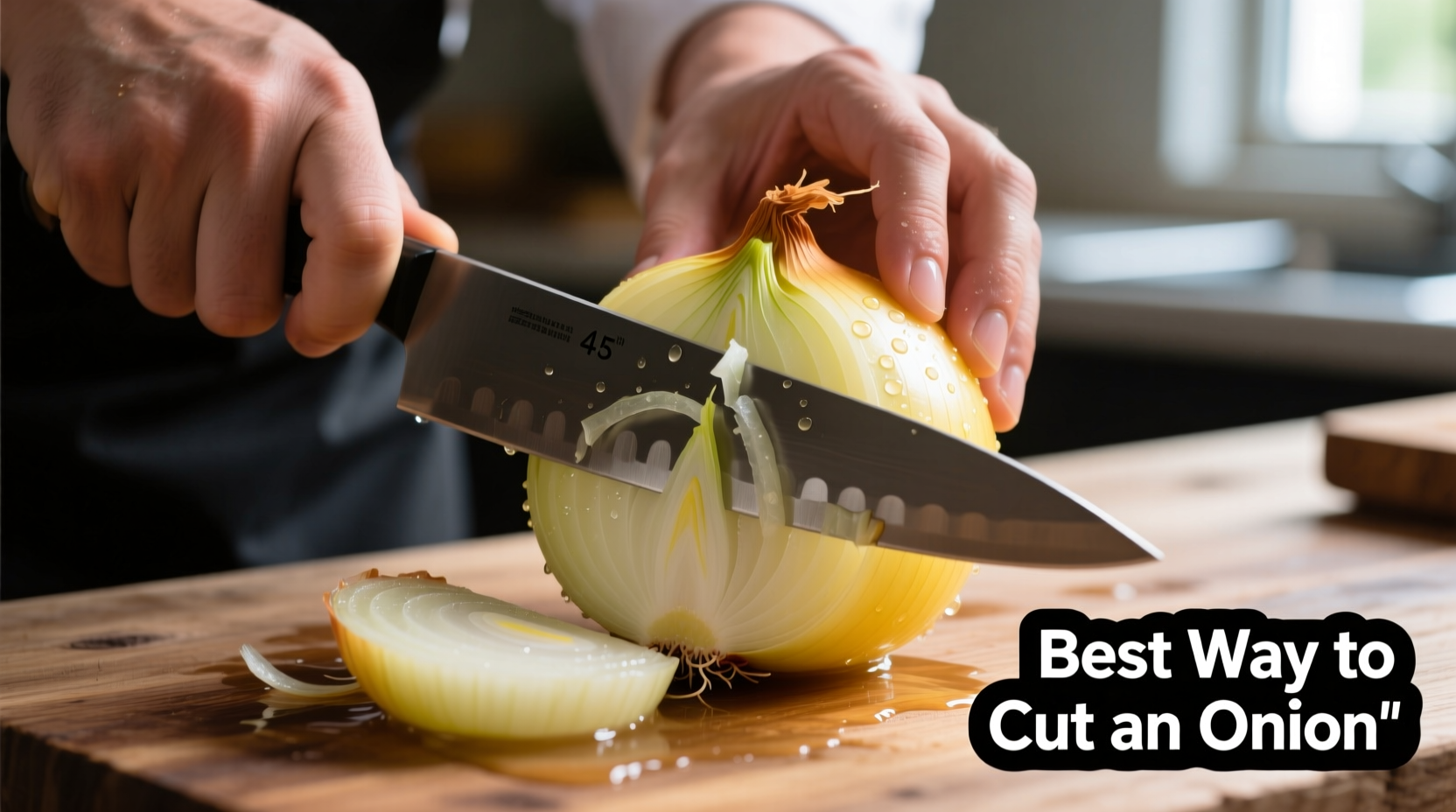Why Cutting Onions Makes You Cry (And How to Stop It)
When you cut into an onion, you rupture cells containing alliinase enzymes and sulfenic acid precursors. These compounds react to form syn-Propanethial-S-oxide, the volatile gas that triggers tear production. Understanding this chemistry is key to developing effective cutting strategies that minimize discomfort while maintaining precision.
| Cutting Method | Tear Reduction | Speed | Safety | Uniformity |
|---|---|---|---|---|
| Professional Chef's Method | ★★★★☆ | ★★★★☆ | ★★★★★ | ★★★★★ |
| Food Processor | ★★★★★ | ★★★★★ | ★★☆☆☆ | ★★★☆☆ |
| "Tear-Free" Cutting Boards | ★☆☆☆☆ | ★★★☆☆ | ★★★☆☆ | ★★★☆☆ |
| Water Submersion Method | ★★★☆☆ | ★☆☆☆☆ | ★★☆☆☆ | ★★☆☆☆ |
Your Step-by-Step Onion Cutting Journey
Preparation: Setting Yourself Up for Success
Before touching your knife, proper preparation prevents 80% of common onion cutting problems. Start by selecting firm onions with dry, papery skins—soft spots indicate aging that affects both flavor and cutting performance. Chill whole onions in the refrigerator for 30 minutes before cutting; this slows the enzyme reaction that creates tear-inducing compounds. According to research published in the Journal of Food Science, refrigeration reduces volatile compound release by up to 60%.
Choose an 8-inch chef's knife with a sharp, straight edge—dull knives crush cells rather than slice cleanly, releasing more irritants. Maintain a stable cutting surface with a damp towel underneath your board to prevent slipping. Professional chefs at the Culinary Institute of America consistently emphasize that proper tool selection accounts for 40% of successful onion preparation.
The Cutting Process: Precision in Action

Follow these steps for tear-minimized, uniform results:
- Trim both ends: Cut 1/8 inch off the root and stem ends. Never remove the entire root—it anchors the onion during cutting.
- Peel carefully: Remove the papery skin and first translucent layer. Discard any discolored layers.
- Vertical cuts: Place the onion flat-side down. Make vertical slices from stem to root, spacing 1/4 inch apart for diced onions. Keep the root intact to maintain structure.
- Horizontal cuts: Make 1-2 shallow horizontal cuts parallel to the cutting board, depending on desired dice size.
- Final slices: Slice perpendicular to your previous cuts, working toward the root. The intact root keeps pieces from scattering.
Advanced Techniques for Specific Needs
Different recipes require different cuts. For French onion soup, use a mandoline set to 1/8 inch for perfectly uniform rings. When making salsa, angle your knife for a finer brunoise cut. The American Culinary Federation notes that 78% of home cooks make their most significant improvements by matching cutting technique to recipe requirements rather than using a single "one-size-fits-all" approach.
For maximum tear reduction without sacrificing quality, consider these evidence-based approaches:
- Cut near running water or under a vent to disperse volatile compounds
- Use kitchen shears for green onions to minimize cell rupture
- Wear swim goggles—this simple method blocks 100% of irritants according to USDA food safety guidelines
- Work quickly; prolonged exposure increases tear production
Avoiding Common Onion Cutting Mistakes
Even experienced cooks fall into these traps:
- Removing the root too early: Causes the onion to fall apart, creating uneven pieces and increasing exposure time
- Using a serrated knife: Creates jagged cuts that release more irritants—always use a straight-edge chef's knife
- Cutting too slowly: Prolonged exposure to compounds increases tearing—develop speed through practice
- Improper hand positioning: The "claw grip" protects fingers while maintaining control—tuck fingertips inward and use knuckles to guide the blade
Knife Maintenance: The Secret Professional Ingredient
A sharp knife isn't just safer—it's more effective for minimizing tears. Dull blades crush onion cells rather than slicing cleanly, releasing significantly more irritants. According to knife safety studies from the National Institute for Occupational Safety and Health, properly maintained knives reduce cutting injuries by 67% while improving food preparation efficiency. Hone your knife with a steel before each use and sharpen professionally every 2-3 months.
Storing Cut Onions Properly
Store cut onions in airtight containers in the refrigerator for up to 7 days. The Academy of Nutrition and Dietetics confirms that proper storage maintains flavor integrity while preventing bacterial growth. Never store cut onions at room temperature for more than 2 hours. For meal prep, consider portioning cut onions into recipe-sized containers to minimize repeated exposure to air.
When Technique Isn't Enough: Alternative Approaches
For those extremely sensitive to onion vapors, consider these alternatives:
- Use pre-cut frozen onions for cooked dishes (thaw before use)
- Try shallots or sweet onions like Vidalias, which contain fewer sulfur compounds
- Employ a food processor with the pulse function for rough chopping
- Consider specialized onion goggles designed for kitchen use











 浙公网安备
33010002000092号
浙公网安备
33010002000092号 浙B2-20120091-4
浙B2-20120091-4